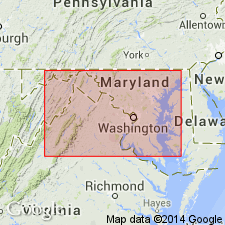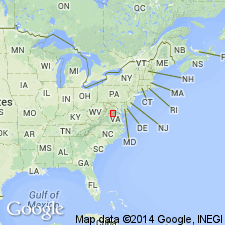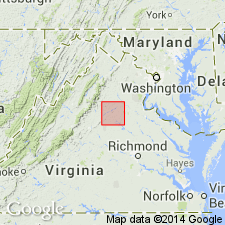
- Usage in publication:
-
- True Blue formation
- Modifications:
-
- First used
- Dominant lithology:
-
- Slate
- Clay
- AAPG geologic province:
-
- Piedmont-Blue Ridge province
Summary:
Continental margin deposits west of the Mountain Run fault zone are westernmost sediments of the back-arc basin. Rocks of the continental margin terrane of VA are those of the here informally named True Blue formation (elsewhere called formation at True Blue). Unit consists mostly of calcareous and noncalcareous slate and lesser amounts of argillite. Overlies series of discontinuous basal metasandstone or quartzite lenses which in turn unconformably overlie Late Proterozoic metavolcanic Catoctin Formation. Near Mountain Run fault unit contains lenses of Everona Limestone.
Source: GNU records (USGS DDS-6; Reston GNULEX).

- Usage in publication:
-
- True Blue Formation
- Modifications:
-
- Overview
- AAPG geologic province:
-
- Piedmont-Blue Ridge province
Summary:
Author's use of True Blue as a formal unit is unintentional (Kline, 1991, oral commun.). Unit is shown in figures 1 and 2 overlying the Catoctin Formation.
Source: GNU records (USGS DDS-6; Reston GNULEX).

- Usage in publication:
-
- True Blue Formation*
- Modifications:
-
- Named
- Dominant lithology:
-
- Slate
- Siltstone
- Argillite
- AAPG geologic province:
-
- Piedmont-Blue Ridge province
Summary:
Named for crossroads of True Blue, Orange Co., central VA. Formerly treated as an informal unit (True Blue formation) by Pavlides (1988, 1990). Occurs in a continuous belt from Boswells Tavern quad north into Unionville quad. Bounded on southeastern side by Mountain Run fault zone, which locally encloses it. Consists mainly of gray, tan-buff-weathering, generally slaty to locally phyllitic metasiltstone or metamudstone. Also includes lenses of quartzite, graywacke, calcareous slate and slaty limestone, black chert, carbonate and oxide ironstones, and platy limestone of Everona Limestone Member (rank reduced from Everona Limestone). Thickness is difficult to evaluate because of folded nature, but is probably at least 600 m thick. Overlies both lenticular Cambrian Nasons Formation (new) and Late Proterozoic Catoctin Formation. In fault contact or overlain by Mesozoic siltstone, arkose, conglomerate, and basaltic rocks of Culpeper basin. Age is Cambrian(?) and (or) Ordovician(?) based on stratigraphic position and on indirect evidence in the form of a 452 Ma (Late Ordovician) age of the Lahore pluton (Pavlides and others, in press) that intrudes Mine Run Complex (a remnant of a back-arc basin that formed against continental margin that included True Blue rocks); Jonas (1927) reported finding undatable trilobite fragments but neither her locality nor her collection could be located. Report includes geologic map and correlation chart.
Source: GNU records (USGS DDS-6; Reston GNULEX).
For more information, please contact Nancy Stamm, Geologic Names Committee Secretary.
Asterisk (*) indicates published by U.S. Geological Survey authors.
"No current usage" (†) implies that a name has been abandoned or has fallen into disuse. Former usage and, if known, replacement name given in parentheses ( ).
Slash (/) indicates name conflicts with nomenclatural guidelines (CSN, 1933; ACSN, 1961, 1970; NACSN, 1983, 2005, 2021). May be explained within brackets ([ ]).

